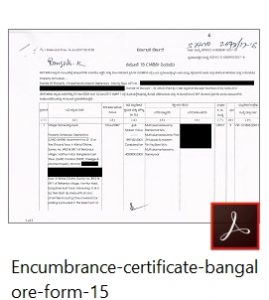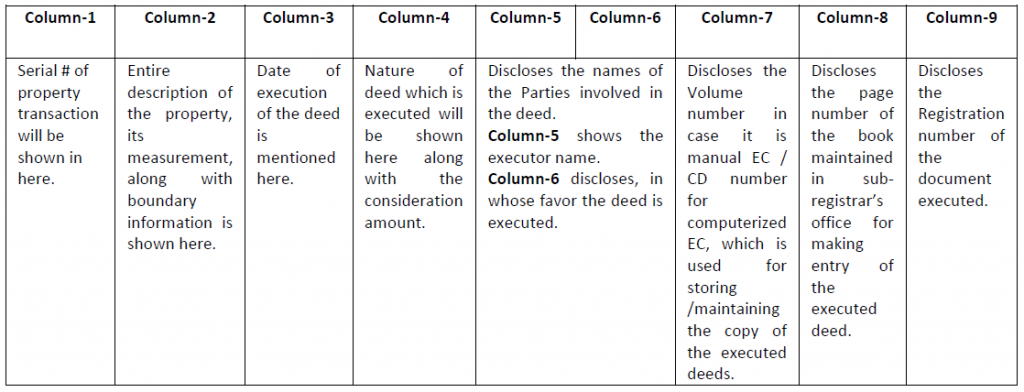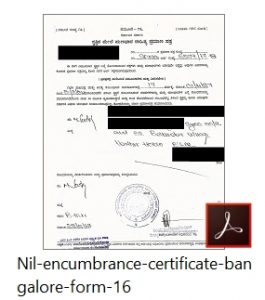
What is Encumbrance Certificate in Bangalore?
The word encumbrance means, ‘a claim on property or assets’ or ‘a mortgage’. Encumbrance certificate in Bangalore is a document issued by the sub-registrar's office which reflects these encumbrances on a particular property in a chronological order. The encumbrance certificate is a mandatory document used in property transactions as an evidence of free title/absolute ownership.
Salient Aspects captured in Encumbrance Certificate
The Encumbrance Certificates identifies two salient aspects of the property –
- Monetary dues. This could lean or mortgages on the said property with banks or financial institutions. For e.g. if the person has taken a home loan then the same would be reflected in the EC.
- Legal liabilities. Identifies if the property has any ongoing property transaction (registered sale agreements) or lease (registered lease agreements). All the details of any registered transaction on the property will be listed in it. E.g. sale deed, gift deed, release deed, partition deed, joint development agreement etc. Those deeds which are indexed in Book 1 of Sub Registrar office, shall be shown on Encumbrance Certificate in Bangalore. If the EC states there is a registered sale agreement on the property, then one should not consider buying it as the seller is already transacting with another buyer.
We can track the registered transactions of the property, consideration amounts (registered property value), property details, date of transactions, type of registered deed, document number registered in sub registrar office and names of parties who transacted, by studying the Encumbrance certificates.
When buying a house, flat or parcel of land, it is important to verify that the property does not have such encumbrances. EC for property can be obtained from the sub-registrar's office where the particular property has been registered. It is one of the many documents that buyers seek, to identify if the property can be bought without any associated items of baggage.
Categories of Encumbrance Certificate in Bangalore
There are two categories of Encumbrance certificates. The encumbrance certificates are provided on Form No 15 or Form No 16.
- Form No. 15, Encumbrance Certificate on Form No. 15 will contain a record of sale, lease, mortgage, gift, partition, release etc. All of this is registered transactions with the competent authorities. These are recorded in Book I that is maintained by the registering authorities.
- Form No. 16, EC on Form 16 signifies that no transactions have been recorded on the property for the period for which the EC is issued. Form 16 is also referred to as ‘Nil Encumbrance Certificate’ (or) Certificate of Nil Encumbrance.
What are the property insights which are not covered in Encumbrance certificate in Bangalore?
There are many aspects of litigation, encroachments, land use status, land conversion procedures, PTCL endorsements, record of rights/tenancy and crops, notifications for acquisition, compliance with town planning guidelines, clarity on current owners’ family tree and their rights, unsecured hand loans, etc. which are not captured in EC. Hence, examining the EC alone is clearly not enough to make the property buying decision. One should consult a property lawyer who examines all these and much more to ensure your investments stay safe.
Zippserv’s Interesting insights
- Not filling up Form 22 correctly leads to ‘Nil Encumbrance Certificate’ (or) Certificate of Nil Encumbrance being issued by the sub-registrar's office. This could be misleading as it leads you to believe that the property has no encumbrances while the reality could be different.
- There is a general misconception that the current owner’s details will be mentioned in the extracted EC. The EC only specifies the property details and lists the registered transactions.
- In case of inherited properties, the current owners’ details may never be shown in the EC. Again, in case the property is assigned through a court order the current owner's details may not be reflected in the EC.
- The current owner’s name will be captured within the transactions in the case he has bought the property himself. His name will also appear if he is a giftee (recipient in a gift deed) or a release (recipient in a release deed), of the said property.
- If you are purchasing the property it is always better to extract the Encumbrance certificate in Bangalore yourself as the EC can tamper. It is always advisable that you take EC from the date of plan sanction yourself. Do not rely on the builder or seller to provide one because there is a good chance that the EC may be defective.
Understanding Form 15 transactions

In this Form, the second line indicates the Property Schedule and details, for which the EC is applied for. In the next paragraph, the time period for which the Encumbrance certificate is being issued is indicated.
There is a Table of 9 columns and contents of each column is described below -

Discloses the Volume number in case it is manual EC / CD number for computerized EC, which is used for storing /maintaining the copy of the executed deeds.
Sample EC in Form 16 format showing NIL transactions.

To know more about how to apply and avail your Encumbrance Certificate in Bangalore from sub-registrar's office.

 080-48574040
080-48574040 0
0
I would like to know about getting an EC urgently..
Thanks
Ambhrini